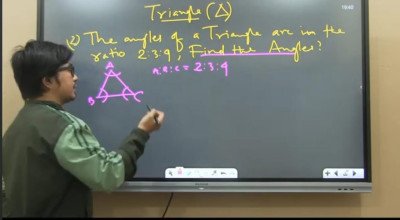Course description
In a class 9 mathematics curriculum, the study of quadrilaterals is essential. Here's an overview of what students typically learn about quadrilaterals:
Definition: A quadrilateral is a polygon with four sides and four vertices.
Classification: Quadrilaterals can be classified into different types based on their properties:
Parallelogram: A quadrilateral with opposite sides parallel and equal in length.
Rectangle: A parallelogram with all angles equal to 90 degrees.
Square: A parallelogram with all sides equal in length and all angles equal to 90 degrees.
Rhombus: A parallelogram with all sides equal in length.
Trapezium (Trapezoid in American English): A quadrilateral with at least one pair of parallel sides.
Kite: A quadrilateral with two distinct pairs of adjacent sides that are equal in length.
Irregular Quadrilateral: A quadrilateral with no special properties, i.e., it doesn't fit into any of the above categories.
Properties:
Interior Angles: The sum of the interior angles of any quadrilateral is always 360 degrees.
Opposite Angles: In any quadrilateral, the sum of the measures of opposite angles is 180 degrees.
Diagonals:
In parallelograms, diagonals bisect each other.
In rectangles and squares, diagonals are equal in length and bisect each other.
In rhombuses, diagonals bisect each other and are perpendicular.
In kites, one diagonal is the perpendicular bisector of the other.
Sides: In quadrilaterals, the sum of the lengths of any two sides is always greater than the lengths of the other two sides.
Area and Perimeter:
Area: Different formulas are used to find the area of various types of quadrilaterals, such as base times height for parallelograms and rectangles, and 1/2 times product of diagonals for kites and rhombuses.
Perimeter: The perimeter of a quadrilateral is the sum of the lengths of its four sides.
ক্লাস 9 গণিত পাঠ্যক্রমে, চতুর্ভুজ অধ্যয়ন অপরিহার্য। ছাত্ররা সাধারণত চতুর্ভুজ সম্পর্কে কী শিখে তার একটি সংক্ষিপ্ত বিবরণ এখানে দেওয়া হল:
সংজ্ঞা: চতুর্ভুজ হল একটি বহুভুজ যার চারটি বাহু এবং চারটি শীর্ষবিন্দু রয়েছে।
শ্রেণীবিভাগ: চতুর্ভুজকে তাদের বৈশিষ্ট্যের উপর ভিত্তি করে বিভিন্ন প্রকারে ভাগ করা যায়:
সমান্তরালগ্রাম: একটি চতুর্ভুজ যার বিপরীত বাহুগুলি সমান্তরাল এবং দৈর্ঘ্যে সমান।
আয়তক্ষেত্র: 90 ডিগ্রি সমান সমস্ত কোণ সহ একটি সমান্তরালগ্রাম।
বর্গাকার: একটি সমান্তরাল বৃত্ত যার সমস্ত বাহু সমান দৈর্ঘ্য এবং সমস্ত কোণ 90 ডিগ্রি।
রম্বস: একটি সমান্তরাল বৃত্ত যার সব বাহুর দৈর্ঘ্য সমান।
ট্রাপিজিয়াম (আমেরিকান ইংরেজিতে ট্র্যাপিজয়েড): একটি চতুর্ভুজ যার অন্তত এক জোড়া সমান্তরাল বাহু রয়েছে।
ঘুড়ি: একটি চতুর্ভুজ যার দৈর্ঘ্যে সমান বাহুর দুটি স্বতন্ত্র জোড়া রয়েছে।
অনিয়মিত চতুর্ভুজ: একটি চতুর্ভুজ যার কোনো বিশেষ বৈশিষ্ট্য নেই, অর্থাৎ, এটি উপরের কোনো বিভাগের সাথে খাপ খায় না।
বৈশিষ্ট্য:
অভ্যন্তরীণ কোণ: যেকোনো চতুর্ভুজের অভ্যন্তরীণ কোণের সমষ্টি সর্বদা 360 ডিগ্রি।
বিপরীত কোণ: যেকোনো চতুর্ভুজে, বিপরীত কোণের পরিমাপের সমষ্টি 180 ডিগ্রি।
তির্যক:
সমান্তরালগ্রামে, কর্ণ পরস্পরকে দ্বিখণ্ডিত করে।
আয়তক্ষেত্র এবং বর্গক্ষেত্রে, কর্ণ দৈর্ঘ্যে সমান এবং একে অপরকে দ্বিখণ্ডিত করে।
রম্বসে, কর্ণ পরস্পরকে দ্বিখণ্ডিত করে এবং লম্ব হয়।
ঘুড়িতে, একটি তির্যক অন্যটির লম্ব দ্বিখণ্ডক।
বাহু: চতুর্ভুজে, যেকোনো দুই বাহুর দৈর্ঘ্যের যোগফল সবসময় অন্য দুই বাহুর দৈর্ঘ্যের চেয়ে বেশি হয়।
এলাকা এবং পরিধি:
ক্ষেত্রফল: বিভিন্ন ধরনের চতুর্ভুজের ক্ষেত্রফল বের করতে বিভিন্ন সূত্র ব্যবহার করা হয়, যেমন সমান্তরালগ্রাম এবং আয়তক্ষেত্রের জন্য ভিত্তি গুণ উচ্চতা এবং কাইট এবং রম্বসের জন্য কর্ণের 1/2 গুণ গুণফল।
পরিসীমা: একটি চতুর্ভুজের পরিধি হল এর চারটি বাহুর দৈর্ঘ্যের সমষ্টি।



















